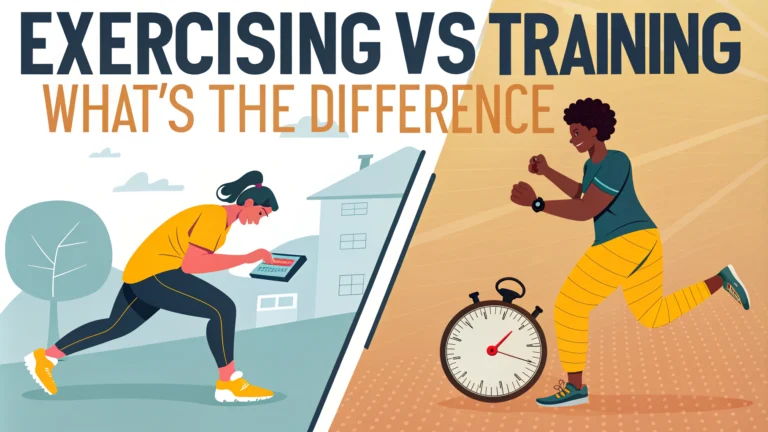Physical activity takes many forms, but understanding the key differences between exercising and training can transform your fitness success. Most people use these terms interchangeably, yet they represent distinct approaches to physical activity with different goals and outcomes.
**Exercise** focuses on movement for general health and wellness, while **training** involves a structured plan targeting specific performance goals. Knowing which approach aligns with your needs helps create more effective workout strategies.
Understanding Exercise vs Training Fundamentals
- Exercise: Regular physical activity without specific performance targets
- Training: Structured program with measurable goals and progression
- Key differences in planning, intensity, and commitment levels
“Exercise is activity done for its own sake, while training is activity done with a specific performance objective in mind.” – Mark Rippetoe
Benefits of Regular Exercise
- **Improved cardiovascular health** and blood circulation
- **Better mood** through endorphin release
- **Weight management** and basic fitness maintenance
- **Stress reduction** and mental clarity
Components of Structured Training
| Element | Purpose |
|---|---|
| Periodization | Planned progression of intensity and volume |
| Goal Setting | Specific, measurable targets |
| Performance Tracking | Regular assessment of progress |
| Recovery Planning | Structured rest periods |
Matching Your Fitness Goals to Your Activity Style
Choosing between exercise and training depends on your current fitness level, available time, and specific objectives. A **regular exercise routine** might work better for general wellness, while **structured training** suits those pursuing performance goals.
Factors to Consider
- Current fitness level and experience
- Time commitment and schedule flexibility
- Access to equipment and facilities
- Personal motivation and accountability needs
Building an Effective Fitness Plan
Start with a **baseline assessment** of your current capabilities and establish clear, measurable goals. Track your progress using workout logs, measurements, or fitness apps.
| Activity Type | Recommended Frequency |
|---|---|
| Cardiovascular Exercise | 3-5 times per week |
| Strength Training | 2-3 times per week |
| Flexibility Work | Daily |
Common Fitness Mistakes to Avoid
- **Skipping warm-ups** and proper form practice
- **Inconsistent scheduling** and random workouts
- **Neglecting recovery** time between sessions
- **Comparing progress** to others instead of personal baselines
“The difference between try and triumph is just a little umph!” – Marvin Phillips
Taking Your Next Fitness Steps
Start with small, **achievable changes** to build lasting habits. Focus on consistency rather than perfection.
Action Steps
- Schedule your workouts like important appointments
- Keep a workout log to track progress
- Join fitness communities for support and motivation
- Reassess and adjust your plan every 4-6 weeks
Remember that both exercise and training have their place in a balanced fitness journey. Choose the approach that best matches your lifestyle and goals, and be ready to adjust as needed.
Frequently Asked Questions: Exercise vs Training
What’s the main difference between exercising and training?
Exercising is physical activity done for general health and wellness, while training involves structured workouts with specific performance goals and measurable outcomes.
Can you do both exercising and training simultaneously?
Yes, many activities can serve both purposes. For example, running can be casual exercise or structured training depending on your:
- Specific goals
- Progress tracking
- Intensity levels
- Program structure
How do I know if I need exercise or training for weight loss?
For weight loss:
- Exercise works well for general calorie burning and maintaining health
- Training is better for specific body composition goals and sustained results
What’s better for beginners: exercise or training?
Beginners should start with basic exercise to build:
- Fundamental movement patterns
- Basic fitness levels
- Exercise habits
Then progress to training when ready for specific goals.
Do professional athletes exercise or train?
Professional athletes primarily train using:
- Periodized programs
- Performance metrics
- Specific skill development
- Strategic recovery periods
How many days per week should I exercise vs train?
General guidelines:
| Activity | Frequency |
|---|---|
| Exercise | 3-5 days/week |
| Training | 4-6 days/week |
Does high-intensity interval training (HIIT) count as exercise or training?
HIIT can be both:
- Exercise when done for general fitness
- Training when part of a structured program with specific goals
What equipment do I need for exercise vs training?
Exercise often requires minimal equipment, while training might need:
- Specialized equipment
- Tracking devices
- Sport-specific gear
- Progress monitoring tools
How long should exercise vs training sessions last?
Typical durations:
| Type | Duration |
|---|---|
| Exercise | 30-60 minutes |
| Training | 45-120 minutes |
Should seniors focus on exercise or training?
Seniors typically benefit more from exercise focusing on:
- Balance
- Mobility
- Functional strength
- Low-impact activities



















